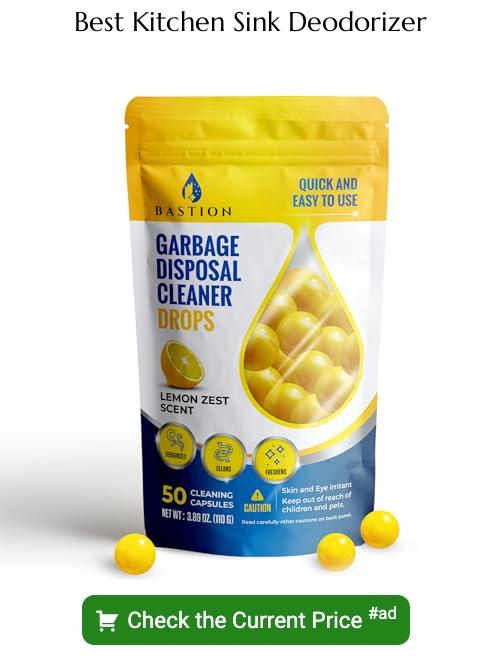Last updated on
Discover the common causes of kitchen sink odors and effective methods to eliminate them for a fresher-smelling home.One of the main culprits behind a smelly kitchen sink is food debris trapped in the garbage disposal or drain. When organic matter begins to decompose, it emits unpleasant odors that can permeate your kitchen. Regularly running the garbage disposal with plenty of water, and cleaning it with baking soda and vinegar can keep odors at bay.Another source of sink smells is the buildup of biofilm in the drain pipes. This slimy layer consists of bacteria, fungi, and other microorganisms feeding on the organic matter that clings to the pipe’s walls. A thorough scrub with a stiff brush and a drain cleaner can remove biofilm and its associated stink.Don’t overlook the importance of a clean P-trap, the curved section of the drainpipe. Trapped water in the P-trap prevents sewer gases from rising up, but if it dries out or becomes clogged with debris, these gases can escape, and a foul smell can arise. Ensure water is flowing into the trap regularly, and if necessary, disassemble and clean it out.In some cases, the issue may stem from venting problems. Every plumbing system needs to vent sewer gases to the outside. If there’s a blockage or malfunction, those gases could be coming back through your sink. Consulting a plumber to assess and fix venting issues is a wise move.Lastly, the material of your sink can also influence odor development. Stainless steel sinks, for example, are less porous than others and tend to harbor fewer bacteria that cause bad smells. Regular cleaning with the right products ensures that material-specific odors are not part of the problem.In sum, keeping the kitchen sink smelling fresh revolves around routine maintenance, cleaning practices, and sometimes, professional intervention to tackle deeper plumbing issues. By addressing these areas, you can wave goodbye to kitchen sink smells and maintain an inviting aroma in your culinary space.
Key takeaways:
- Food debris in garbage disposal causes sink smells.
- Biofilm in drain pipes creates foul odors.
- Clean P-trap to prevent sewer gas escape.
- Venting issues can cause sink odors.
- Stainless steel sinks harbor fewer bacteria and odors.
What's Inside
Identifying the Source of Sink Smells

Pinpointing the precise reason for unpleasant odors emanating from your kitchen sink is crucial to tackling the issue effectively. Often, the stench is a telltale sign of food particles trapped in the drain or garbage disposal, where they start to decompose, creating a breeding ground for bacteria that produce foul smells. Grease and oil buildup can also contribute to the pungent aroma, as they catch food and create a sludge that emits odors.
If the smell seems to emanate from the sink itself without a noticeable blockage, the issue may be in the drain trap. The U-shaped pipe under the sink, designed to hold standing water and prevent sewer gases from entering your kitchen, can sometimes dry out or become so clogged that it cannot perform its job effectively.
On occasion, the unpleasant smell might hint at a more serious problem such as a sewer gas leak, caused by cracks or loose fittings in the pipes. The smell of sewer gas is often unmistakable and should be attended to promptly due to the potential health risks and implications for your plumbing system.
By taking the time to sniff out the origin of the scent, you’ll be better equipped to select the most appropriate solution and restore freshness to your kitchen space.
Common Culprits Behind Kitchen Sink Odors
Kitchen sink smells often stem from a handful of sources. Rotting food particles trapped in the drain or garbage disposal create an ideal environment for bacteria to thrive and emit foul odors. Grease and oil solidifying within the pipes can also contribute to unpleasant smells, as can a dry P-trap, which normally contains water that blocks sewer gases but can dry out, especially in homes where the sink isn’t used frequently.
Additionally, a clogged vent pipe responsible for redirecting sewer gases out through the roof, if blocked, can cause those gases to back up into the home, producing a smell. Lastly, mold and mildew growth in the damp, dark areas around the sink or within overflows can release musty odors into the kitchen air. Identifying the source is crucial for applying the correct remedy and restoring freshness to the area.
Dealing With Sink Smells
A simple yet effective remedy to banish those unpleasant odors is the dynamic duo of baking soda and vinegar. Here’s how to wield these kitchen staples for a fresher-smelling sink:
1. Start with a dry sink and pour about half a cup of baking soda directly into the drain. Baking soda is a natural deodorizer and gentle abrasive, so it helps in scrubbing away the gunk causing the stink.
2. Chase the baking soda with one cup of white vinegar. The chemical reaction between these two creates a fizzing action that reaches into the nooks and crannies, breaking up residue.
3. Allow the fizz to work its magic for a few minutes. This waiting time is crucial as it lets the concoction thoroughly cleanse the pipes.
4. Finally, rinse it all down with boiling water. The heat helps to dissolve and flush away what the baking soda and vinegar have loosened up.
This process not only tackles smells but also works wonders in removing minor clogs and maintaining a clear drain. It’s a natural solution that dodges the harshness of chemical cleaners, keeping both your sink and environment in mind.
Baking Soda and Vinegar Reaction
Harness the power of chemistry to battle kitchen sink odors with just two pantry staples: baking soda and vinegar. This dynamic duo works wonders due to a simple yet effective reaction. When combined, they create carbonic acid, which immediately decomposes into carbon dioxide gas and water, providing a fizzy assault on grime and smells.
Here’s why this reaction is your sink’s best friend:
- Natural Scrubbing Action: The bubbling effect helps physically remove buildup from the pipes, with the expansion reaching into nooks and crannies.
- Deodorizing Properties: Baking soda neutralizes acidic odors, while vinegar’s acetic acid tackles alkaline scents, ensuring a fresh smell post-treatment.
- Non-toxic Cleaning: Safe for your family and the environment, this mixture avoids the health hazards associated with harsh chemicals.
- Simple and Cost-effective: No need for expensive cleaners when these common household items are within reach.
Remember, while an occasional treatment shines in maintenance, it’s not a cure-all. For stubborn issues, additional steps may be required.
Preventing Future Smells
Adopting a proactive mindset in maintaining your kitchen sink can be your best defense against future foul odors. Here’s how to keep your sink fresh:
1. Regular Cleaning Routines: Incorporate the cleaning of your sink into your daily kitchen tidy-up schedule. A quick rinse with soap and hot water after dishwashing can help prevent residue build-up.
2. Proper Disposal of Food Waste: Leftover food should find its way into the compost or trash bin, not down the sink. Even with a garbage disposal, certain food items can contribute to smells if not properly broken down.
3. Routine Garbage Disposal Maintenance: If you have a garbage disposal, grind ice cubes and orange peels or a dedicated cleaner once a month. This not only sharpens the blades but also helps dislodge any trapped debris and provides a citrusy freshness.
4. Use of Drain Guards: These handy tools catch solids before they go down the drain. Remember to empty the guards regularly to prevent odor caused by rotting food particles.
By implementing these simple practices, your kitchen sink will remain a pleasant and odor-free part of your daily cooking and cleaning experience.





